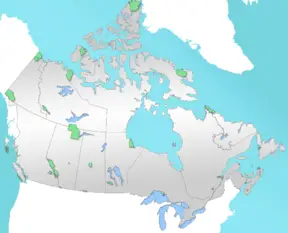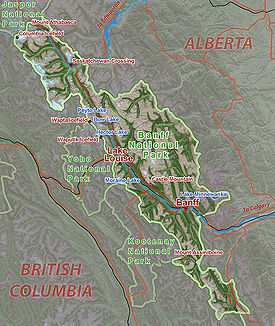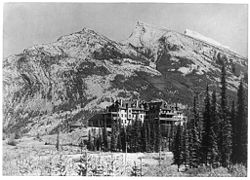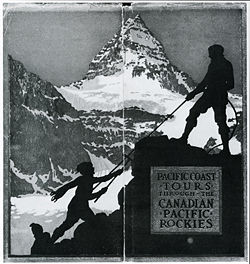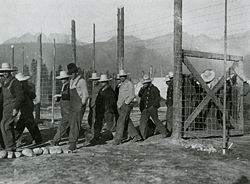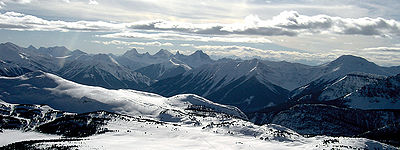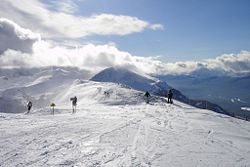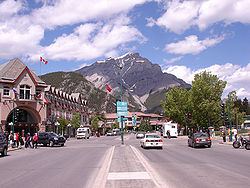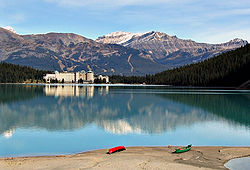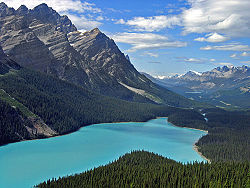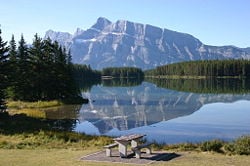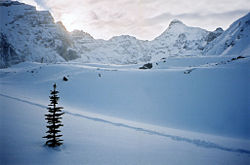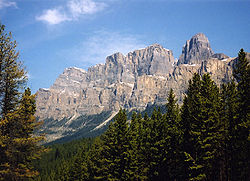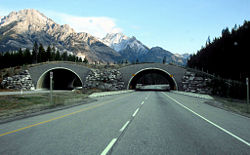Difference between revisions of "Banff National Park" - New World Encyclopedia
Mary Anglin (talk | contribs) |
|||
| Line 1: | Line 1: | ||
| − | {{claimed}} | + | {{Images OK}}{{claimed}} |
{{Infobox_protected_area | name = Banff National Park | {{Infobox_protected_area | name = Banff National Park | ||
| Line 28: | Line 28: | ||
The [[Canadian Pacific Railway]] was instrumental in Banff's early years, building the [[Banff Springs Hotel]] and [[Chateau Lake Louise]], and attracting tourists through extensive advertising. In the early 20th century, roads were built in Banff, at times by war internees, and through [[Great Depression]]-era public works projects. Since the 1960s, park accommodations have been open all year, with annual tourism visits to Banff increasing to over 5 million in the 1990s.<ref>{{cite web |url=http://www.pc.gc.ca/pn-np/ab/banff/docs/routes/chap1/routes1a_e.asp |title=Highway Mitigation Research |publisher=Parks Canada |accessdate=2006-09-01}}</ref> Millions more pass through the park on the [[Trans-Canada Highway]].<ref name="transcanada">{{cite news |title=A Highway Runs Through It |author=Savage, Candace |publisher=Canadian Geographic |date=July/August 2000 |pages=34–42}}</ref> As Banff is one of the world's most visited national parks,<ref name="bnpc">{{cite web |url=http://www.pc.gc.ca/pn-np/ab/banff/plan/plan7-05_E.asp#nov03 |title=Park Management, Annual Planning Forum 2005 |publisher=Parks Canada |accessdate=2006-07-12}}</ref> the health of its ecosystem has been threatened. In the mid-1990s, [[Parks Canada]] responded by initiating a two-year study, which resulted in management recommendations, and new policies that aim to preserve ecological integrity. | The [[Canadian Pacific Railway]] was instrumental in Banff's early years, building the [[Banff Springs Hotel]] and [[Chateau Lake Louise]], and attracting tourists through extensive advertising. In the early 20th century, roads were built in Banff, at times by war internees, and through [[Great Depression]]-era public works projects. Since the 1960s, park accommodations have been open all year, with annual tourism visits to Banff increasing to over 5 million in the 1990s.<ref>{{cite web |url=http://www.pc.gc.ca/pn-np/ab/banff/docs/routes/chap1/routes1a_e.asp |title=Highway Mitigation Research |publisher=Parks Canada |accessdate=2006-09-01}}</ref> Millions more pass through the park on the [[Trans-Canada Highway]].<ref name="transcanada">{{cite news |title=A Highway Runs Through It |author=Savage, Candace |publisher=Canadian Geographic |date=July/August 2000 |pages=34–42}}</ref> As Banff is one of the world's most visited national parks,<ref name="bnpc">{{cite web |url=http://www.pc.gc.ca/pn-np/ab/banff/plan/plan7-05_E.asp#nov03 |title=Park Management, Annual Planning Forum 2005 |publisher=Parks Canada |accessdate=2006-07-12}}</ref> the health of its ecosystem has been threatened. In the mid-1990s, [[Parks Canada]] responded by initiating a two-year study, which resulted in management recommendations, and new policies that aim to preserve ecological integrity. | ||
| + | |||
| + | |||
| + | ==Geography== | ||
| + | [[Image:Banffmapv2.jpg|thumb|275px|Map of Banff National Park]] | ||
| + | |||
| + | Banff National Park is located on [[Alberta]]'s western border with [[British Columbia]]. Banff is about an hour and half driving distance from [[Calgary]], and four hours from [[Edmonton]]. [[Jasper National Park]] is located to the north, while [[Yoho National Park]] is to the west, and [[Kootenay National Park]] is to the south. [[Kananaskis, Alberta|Kananaskis Country]], which includes [[Bow Valley Wildland Provincial Park]], [[Spray Valley Provincial Park]], and [[Peter Lougheed Provincial Park]], is located to the south and east of Banff. | ||
| + | |||
| + | The [[Trans-Canada Highway]] passes through Banff National Park, from the eastern boundary near [[Canmore, Alberta|Canmore]], through the towns of Banff and [[Lake Louise, Alberta|Lake Louise]], and into Yoho National Park in British Columbia. The Banff townsite is the main commercial center in the national park. The village of Lake Louise is located at the junction of the Trans-Canada Highway and the Icefields Parkway, which extends north to the Jasper townsite. | ||
| + | |||
| + | === Villages in the Park === | ||
| + | The Town of Banff, established in 1883, is the main commercial center in Banff National Park, as well as a center for cultural activities. Banff is home to several cultural institutions, including the [[Banff Center]], the [[Whyte Museum]], the [[Buffalo Nations Luxton Museum]], [[Cave and Basin National Historic Site]], and several [[art gallery|art galleries]]. Throughout its history, Banff has hosted many annual events, including Banff Indian Days which began in 1889, and the Banff Winter Carnival. Since 1976, The Banff Center has organized the [[Banff Mountain Film Festival]]. In 1990, the town was incorporated as a municipality of [[Alberta]], though still subject to the Canada National Parks Act and federal authority in regards to planning and development. As of the 2005 [[census]], the Town of Banff had a population of 8,352, of which nearly 7,000 were permanent residents. The Bow River flows through the town of Banff, with the [[Bow Falls]] located on the outskirts of town. | ||
| + | |||
| + | Lake Louise, a small village located 32 miles west of the Banff townsite, is home to the landmark [[Chateau Lake Louise]] at the edge of Lake Louise. Located 9.3 miles from Lake Louise, [[Moraine Lake]] provides a scenic vista of the [[Valley of the Ten Peaks]]. This scene was pictured on the back of the $20 [[Canadian banknotes|Canadian banknote]], in the 1969–1979 ("Scenes of Canada") series. The [[Lake Louise Mountain Resort]] is also located near the village. | ||
| + | |||
| + | The Icefields Parkway, which extends 143 miles, connects Lake Louise to Jasper, [[Alberta]]. The Parkway originates at Lake Louise, and extends north up the Bow Valley, past [[Hector Lake]], [[Bow Lake (Alberta)|Bow Lake]], and [[Peyto Lake]]. The Parkway then crosses a summit, and follows the [[Mistaya River]] to [[Saskatchewan Crossing, Alberta|Saskatchewan Crossing]], where it converges with the [[Howse River|Howse]] and [[North Saskatchewan River]]. | ||
| + | |||
| + | The [[North Saskatchewan River]] flows east from Saskatchewan Crossing, out of Banff, into what is known as David Thompson country, and onto Edmonton. The [[Alberta Highway 11|David Thompson Highway]] follows the North Saskatchewan River, past the man-made [[Abraham Lake]], and through David Thompson Country. | ||
| + | |||
| + | North of Saskatchewan Crossing, the Icefields Parkway follows the North [[Saskatchewan River]] up to the [[Columbia Icefield]]. The Parkway crosses into Jasper National Park at Sunwapta Pass at 6,635 feet in elevation, and continues from there to the Jasper townsite. | ||
| + | |||
| + | ===Climate=== | ||
| + | |||
| + | Located on the eastern side of the [[Continental Divide]], Banff National Park receives an annual average of 19 inches of precipitation. This is considerably less than is received in Yoho National Park on the western side of the divide in [[British Columbia]], with 35 inch annual precipitation at [[Wapta Lake]] and 26 inches at Boulder Creek. Ninety-two inches of [[snow]] falls on average each winter in the Banff townsite, while 114 inches falls in Lake Louise. | ||
| + | |||
| + | During winter months, [[temperature]]s in Banff are moderate, compared to Edmonton and other areas of central and northern [[Alberta]], due to [[Chinook wind]]s and other influences from [[British Columbia]]. The mean low temperature during January is -6° [[Fahrenheit|F]], and the mean high temperature is -24°F for the Town of Banff. Weather conditions during summer months are pleasant, with high temperatures during July averaging 71°F, and daily low temperatures averaging 45°F. | ||
| + | |||
| + | ==Geology== | ||
| + | The [[Rocky Mountains|Canadian Rockies]] consist of several northwest-southeast trending ranges. Closely following the [[continental divide]], the Main Ranges form the backbone of the Canadian Rockies. The Front Ranges are located east of the Main Ranges. Banff National Park extends eastward from the continental divide and includes the eastern slope of the Main Ranges and much of the Front Ranges. The latter include the mountains around the Banff townsite. The foothills are located to the east of the Park, between [[Calgary]] and [[Canmore]]. On the other side of the Park, the Western Ranges pass through Yoho and Kootenay National Parks. Still farther west is the [[Rocky Mountain Trench]], the western boundary of the Canadian Rockies region in [[British Columbia]]. | ||
| + | |||
| + | The Canadian Rockies are composed of [[sedimentary rock]], including [[shale]], [[sandstone]], [[limestone]], and [[quartzite]], that originated as deposits in a shallow inland sea. The [[geologic formation]]s in Banff range in age from [[Precambrian]] eon to the [[Jurassic]] period. The mountains were formed 80–120 million years ago, as a product of [[thrust fault]]s. | ||
| + | |||
| + | Over the past 80 million years, [[erosion]] has taken its toll on the landscape, with more extensive erosion occurring in the foothills and Front Range than in the Main Range. Banff's mountains exhibit several different shapes that have been influenced by the composition of rock deposits, layers, and their structure. Numerous mountains in Banff are carved out of sedimentary layers that slope at 50–60 degree angles. Such [[dip slope]] mountains have one side with a steep face, and the other with a more gradual slope that follows the layering of the rock formations, such as the example of [[Mount Rundle]], near the Banff townsite. | ||
| + | |||
| + | Other types of mountains in Banff include complex, irregular, [[anticline|anticlinal]], [[syncline|synclinal]], castellate, dogtooth, and sawback mountains. <ref name="baird">{{cite book |author=Baird, D.M. |title=Banff National Park, How Nature Carved Its Splendor |date=1977 |publisher=Hurtig Publishers}}</ref> [[Castle Mountain]] exemplifies a castellate shape, with steep slopes and cliffs. The top section of Castle Mountain is composed of a layer of [[Paleozoic]]-era shale, <ref name="langshaw">{{cite book |title=Geology of the Canadian Rockies |author=Langshaw, Rick |publisher=Summerthought |date=1989}}</ref> sandwiched between two limestone layers. Dogtooth mountains, such as [[Mount Louis]], exhibit sharp, jagged slopes. The [[Sawback Range]], which consists of dipping sedimentary layers, has been eroded by cross [[gully|gullies]]. [[Scree]] deposits are common toward the bottom of many mountains and cliffs. | ||
| + | |||
| + | Banff's landscape has also been marked by glacial erosion, with deep [[U-shaped valley]]s and many [[hanging valley]]s that often form [[waterfall]]s. Matterhorn-type mountains, such as [[Mount Assiniboine]], have been shaped by glacial erosion that has left a sharp peak. A number of small [[gorge]]s also exist, including [[Mistaya Canyon]] and [[Johnston Canyon]]. | ||
| + | |||
| + | ===Glaciers and icefields=== | ||
| + | Banff National Park has numerous large glaciers and icefields, many of which are easily accessed from the Icefields Parkway. Small [[cirque glacier]]s are fairly common in the Main Ranges, situated in depressions on the side of many mountains. As with the majority of mountain glaciers around the world, the glaciers in Banff are retreating. Photographic evidence alone provides testimony to this retreat and the trend has become alarming enough that [[glaciologist]]s have commenced researching the [[glacier]]s in the park more thoroughly, and have been analyzing the impact that reduced glacier [[ice]] may have on [[water]] supplies to [[stream]]s and [[river]]s. The largest glaciated areas include the [[Waputik Icefield|Waputik]] and [[Wapta Icefield]]s, which both lie on the Banff-Yoho National Park border. Wapta Icefield covers approximately 31 square miles in area.<ref name="p1386j">{{cite paper |author=Ommanney C.S.L. |date=2002 |title=Glaciers of the Canadian Rockies, Professional Paper 1386-J (Glaciers of North America) |url=http://pubs.usgs.gov/prof/p1386j/ |publisher=U.S. Geological Survey}}</ref> Outlets of Wapta Icefield on the Banff side of the continental divide include [[Peyto Glacier|Peyto]], [[Bow Glacier|Bow]], and [[Vulture Glacier]]s. Bow Glacier retreated an estimated 3,600 feet between the years 1850 and 1953,<ref name="p1386j"/> and since that period, there has been further retreat which has left a newly formed lake at the terminal [[moraine]]. Peyto Glacier has retreated approximately 6561 feet since 1880,<ref>{{cite web |title=Glacier Related Impacts of Doubling Atmospheric Carbon Dioxide Concentrations on British Columbia and Yukon |author=Brugman, Melinda M., Paul Raistrick, and Alain Pietroniro |date=1997 |work=Responding to Global Climate Change in British Columbia and Yukon |publisher=British Columbia Ministry of Environment, Lands and Parks |url=http://dsp-psd.communication.gc.ca/Collection/En56-119-1997E.pdf |format=pdf}}</ref> and is at risk of disappearing entirely within the next 30 to 40 years.<ref>{{cite web |url=http://adaptation.nrcan.gc.ca/app/filerepository/6BD9CB0B92E64244BA26A1AC6EEC10AD.pdf |title=Climate Change & Banff National Park: Implications for Tourism and Recreation |author=Scott, D. and Jones, B. |date=2005 |format=pdf |publisher=University of Waterloo}}</ref> Both [[Crowfoot Glacier|Crowfoot]] and [[Hector Glacier]]s are also easily visible from the Icefields Parkway, yet they are singular glaciers and are not affiliated with any major icesheets. | ||
| + | |||
| + | The [[Columbia Icefield]], at the northern end of Banff, straddles the Banff and Jasper National Park border and extends into [[British Columbia]]. [[Snow Dome (Canada)|Snow Dome]], in the Columbia Icefields, forms a hydrological apex of [[North America]], with water flowing from this point in to the [[Pacific Ocean|Pacific]] via the [[Columbia River|Columbia]], the [[Arctic Ocean]] via the [[Athabasca River]], and into the [[Hudson Bay]] and ultimately into the [[Atlantic Ocean]], via the [[North Saskatchewan River]].<ref name="p1386j"/> [[Saskatchewan Glacier]], which is approximately 8 miles in length and 11.6 square miles in area,<ref name="p1386j"/> is the major outlet of the Columbia Icefield that flows into Banff. Between the years 1893 and 1953, Saskatchewan Glacier had retreated a distance of 4,474 feet, with the rate of retreat between the years 1948 and 1953 averaging 180 feet per year.<ref name="p1386j"/> Overall, the glaciers of the [[Canadian Rockies]] lost 25 percent of their mass during the 20th century.<ref>{{cite web |title=Going, Going, Gone, Climate Change and Global Glacier Decline |url=http://assets.panda.org/downloads/glacierspaper.pdf#search='Banff%20glaciers%20retreating' |author=''WWF International'' |format= pdf |date= |publisher= | |accessdate=November 20, 2007}}</ref> | ||
| + | |||
| + | ==Biology== | ||
| + | ===Ecoregions=== | ||
| + | Banff National Park spans three [[ecoregion]]s, including [[montane]], [[subalpine]], and [[alpine climate|alpine]]. The subalpine ecoregion, which consists mainly of dense forest, comprises 53 percent of Banff's area. 27 percent of the park is located above the [[tree line]], in the alpine ecoregion.<ref name="ecoregions">{{cite web |url=http://www.pc.gc.ca/pn-np/ab/banff/plan/plan8a_E.asp |title=Ecoregions of Banff National Park |publisher=Parks Canada}}</ref> The tree line in Banff lies approximately at 7,544 ft.,<ref name="gadd-1992"/> with open [[meadow]]s at alpine regions and some areas covered by glaciers. A small portion (3 percent) of the park, located at lower elevations, is in the montane ecoregion.<ref name="ecoregions"/> [[Lodgepole pine]] forests dominate the montane region of Banff, with [[Engelmann Spruce|Englemann spruce]], [[willow]], [[aspen]], occasional [[Douglas-fir]] and a few [[Douglas maple]] interspersed. Englemann spruce are more common in the subalpine regions of Banff, with some areas of lodgepole pine, and [[subalpine fir]].<ref name="hebblewhite">{{cite journal |title=Elk population dynamics in areas with and without predation by recolonizing wolves in Banff National Park, Alberta |author=Hebblewhite, Mark, Daniel H. Pletscher, and Paul C. Paquet |journal=Canadian Journal of Zoology |date=2002 |volume=80 |pages=789–799}}</ref> The montane areas, which tend to be the preferred habitat for wildlife, have been subjected to significant [[human]] development over the years. | ||
| + | |||
| + | ===Wildlife=== | ||
| + | [[Image:Two elk banff.jpg|thumb|right|250px|[[Elk]] in Banff]] | ||
| + | The park has 56 mammal species that have been recorded. [[Grizzly Bear|Grizzly]] and [[American Black Bear|Black bear]]s inhabit the forested regions. [[Cougar]], [[Lynx]], [[Wolverine]], [[weasel]], [[Northern River Otter]] and [[Grey Wolf|wolves]] are the primary predatory mammals. [[Elk]], [[Mule Deer]] and [[White-tailed Deer]] are common in the valleys of the park, including around (and sometimes in) the Banff townsite, while [[Moose]] tend to be more elusive, sticking primarily to wetland areas and near streams. In the alpine regions, [[Mountain Goat]]s, [[Bighorn Sheep]], [[marmot]]s and [[pika]] are widespread. Other mammals such as [[Beaver]], [[Porcupine]], [[squirrel]], [[chipmunk]]s are the more commonly observed smaller mammals.<ref name="UNEP">{{cite web |url=http://www.unep-wcmc.org/protected_areas/data/wh/rockies.html |title=Canadian Rocky Mountain Parks |publisher=United Nations Environment Programme |accessdate=2006-07-12}}</ref> | ||
| + | In 2005, a total of five [[caribou]] where counted, making this species one of the rarest mammals found in the park.<ref name="bnpc"/> | ||
| + | |||
| + | Due to the harsh winters, the park has few [[reptile]]s and [[amphibian]]s with only one species of [[toad]], three species of [[frog]], one [[salamander]] species and two species of [[snake]]s that have been identified.<ref name="UNEP"/> At least 280 species of birds can be found in Banff including [[Bald Eagle|Bald]] and [[Golden Eagle]]s, [[Red-tailed Hawk]], [[Osprey]], [[Falcon]] and [[Merlin (bird)|Merlin]], all of which are predatory species. Additionally, commonly seen species such as the [[Gray Jay]], [[American Three-toed Woodpecker]], [[Mountain Bluebird]], [[Clark's Nutcracker]], [[Mountain Chickadee]] and [[pipit]] are frequently found in the lower elevations. The [[White-tailed Ptarmigan]] is a ground bird that is often seen in the alpine zones. [[River]]s and [[lake]]s are frequented by over a hundred different species including [[loon]]s, [[heron]]s, and [[mallard]]s who spend their summers in the park.<ref name="UNEP"/> | ||
| + | |||
| + | [[Endangered species]] in Banff include the Banff Springs [[Snail]] ''Physella johnsoni'' which is found in the hot springs of Banff.<ref>{{cite web |url=http://www.speciesatrisk.gc.ca/search/speciesDetails_e.cfm?SpeciesID=311 |title=Species at risk - Banff Springs Snail |publisher=Environment Canada |accessdate=2006-08-02}}</ref> Woodland caribou, found in Banff, are listed as a [[threatened species]], as are grizzly bears. | ||
| + | |||
| + | ===Mountain pine beetles=== | ||
| + | [[Mountain pine beetle]]s have caused a number of large-scale infestations in Banff National Park, feeding off of the [[phloem]] of mature lodgepole pines. Alberta's first known outbreak occurred in 1940, infecting 17 square miles of forest in Banff.<ref>{{cite web|url=http://www.srd.gov.ab.ca/forests/health/pdf/Chap%201.pdf |title=Mountain Pine Beetle Management Guide |publisher=Sustainable Resource Development, Government of Alberta |date=2004, January}}</ref> A second major outbreak occurred in the late 1970s and early 1980s in Banff and the surrounding Rocky Mountains region. | ||
| + | |||
==History== | ==History== | ||
| Line 36: | Line 94: | ||
[[Image:James Hector 1858.jpg|thumb|130px|right|Dr. [[James Hector]]]] | [[Image:James Hector 1858.jpg|thumb|130px|right|Dr. [[James Hector]]]] | ||
| − | With the admission of [[British Columbia]] to [[Canada]] on | + | With the admission of [[British Columbia]] to [[Canada]] on July 20, 1871, Canada agreed to build a [[transcontinental railroad]]. Construction of the railroad began in 1875, with [[Kicking Horse Pass]] chosen, over the more northerly [[Yellowhead Pass]], as the route through the Canadian Rockies.<ref name="lothian"/> Ten years later, the last spike was driven in [[Craigellachie, British Columbia]]. |
===Rocky Mountains Park established=== | ===Rocky Mountains Park established=== | ||
| − | With conflicting claims over discovery of hot springs in Banff, Prime Minister John A. Macdonald decided to set aside a small reserve of 10 square miles around the hot springs at [[Cave and Basin]] as a public park in 1885. Under the [[Rocky Mountains Park Act]], enacted on | + | With conflicting claims over discovery of hot springs in Banff, Prime Minister John A. Macdonald decided to set aside a small reserve of 10 square miles around the hot springs at [[Cave and Basin]] as a public park in 1885. Under the [[Rocky Mountains Park Act]], enacted on 23 June 1887, the park was expanded to 260 square miles<ref name="hildebrant-1995"/> and named ''Rocky Mountains Park''. This was [[Canada]]'s first [[Canadian National Parks|national park]], and the second established in [[North America]], after [[Yellowstone National Park]]. The Canadian Pacific Railway built the [[Banff Springs Hotel]] and [[Chateau Lake Louise]] to attract tourists and increase the number of rail passengers. |
[[Image:Banff springs hotel 1902.jpg|thumb|left|250px|Banff Springs Hotel, 1902]] | [[Image:Banff springs hotel 1902.jpg|thumb|left|250px|Banff Springs Hotel, 1902]] | ||
Early on, Banff was popular with wealthy [[Europe]]an tourists, who arrived in Canada via trans-Atlantic [[luxury liner]] and continued westward on the railroad,<ref name="hildebrant-1995"/> as well as upper-class American and English tourists. Some visitors participated in [[mountaineering]] activities, often hiring local [[guide]]s. [[Tom Wilson (mountaineer)|Tom Wilson]], along with Jim and Bill Brewster, was among the first outfitters in Banff. The [[Alpine Club of Canada]], established in 1906 by [[Arthur Oliver Wheeler]] and [[Elizabeth Parker (journalist)|Elizabeth Parker]], organized [[mountain climbing|climbs]] and camps in the backcountry. | Early on, Banff was popular with wealthy [[Europe]]an tourists, who arrived in Canada via trans-Atlantic [[luxury liner]] and continued westward on the railroad,<ref name="hildebrant-1995"/> as well as upper-class American and English tourists. Some visitors participated in [[mountaineering]] activities, often hiring local [[guide]]s. [[Tom Wilson (mountaineer)|Tom Wilson]], along with Jim and Bill Brewster, was among the first outfitters in Banff. The [[Alpine Club of Canada]], established in 1906 by [[Arthur Oliver Wheeler]] and [[Elizabeth Parker (journalist)|Elizabeth Parker]], organized [[mountain climbing|climbs]] and camps in the backcountry. | ||
| Line 74: | Line 132: | ||
In the 1990s, development plans for the park, including expansion at Sunshine Village, were under fire with lawsuits filed by [[Canadian Parks and Wilderness Society]] (CPAWS). In the mid-1990s, the Banff-Bow Valley Study was initiated to find ways to better address environmental concerns, and issues relating to development in the park. | In the 1990s, development plans for the park, including expansion at Sunshine Village, were under fire with lawsuits filed by [[Canadian Parks and Wilderness Society]] (CPAWS). In the mid-1990s, the Banff-Bow Valley Study was initiated to find ways to better address environmental concerns, and issues relating to development in the park. | ||
| − | |||
| − | |||
| − | |||
| − | |||
| − | |||
| − | |||
| − | |||
| − | |||
| − | |||
| − | |||
| − | |||
| − | |||
| − | |||
| − | |||
| − | |||
| − | |||
| − | |||
| − | |||
| − | |||
| − | |||
| − | |||
| − | |||
| − | |||
| − | |||
| − | |||
| − | |||
| − | |||
| − | |||
| − | |||
| − | |||
| − | |||
| − | |||
| − | |||
| − | |||
| − | |||
| − | |||
| − | |||
| − | |||
| − | |||
| − | |||
| − | |||
| − | |||
| − | |||
| − | |||
| − | |||
| − | |||
| − | |||
| − | |||
| − | |||
| − | |||
| − | |||
| − | |||
| − | |||
| − | |||
| − | |||
| − | |||
| − | |||
| − | |||
| − | |||
| − | |||
| − | |||
| − | |||
==Tourism== | ==Tourism== | ||
| Line 149: | Line 145: | ||
==Park management== | ==Park management== | ||
| − | Banff National Park is managed by [[Parks Canada]], under the [[National Parks Act (Canada)|National Parks Act]] which was passed in 1930. Over time, park management policies have increasingly emphasized environmental protection over development. In 1964, a policy statement was issued that reiterated ideals of conservation laid out in the 1930 act. With the controversial bid for the 1972 Winter [[Olympics]], environmental groups became more influential, leading Parks Canada to withdraw its support for the bid. The 1979 Beaver Book was a major new policy, which emphasized [[Conservation ethic|conservation]]. In 1988, the National Parks Act was amended, making the maintenance of ecological integrity the top priority. The amendment also paved the way for [[non-governmental organizations]] to challenge Parks Canada in court, for breaches in adhering to the act. In 1994, Parks Canada established revised "Guiding Principles and Operating Policies" | + | Banff National Park is managed by [[Parks Canada]], under the [[National Parks Act (Canada)|National Parks Act]] which was passed in 1930. Over time, park management policies have increasingly emphasized environmental protection over development. In 1964, a policy statement was issued that reiterated ideals of conservation laid out in the 1930 act. With the controversial bid for the 1972 Winter [[Olympics]], environmental groups became more influential, leading Parks Canada to withdraw its support for the bid. The 1979 Beaver Book was a major new policy, which emphasized [[Conservation ethic|conservation]]. In 1988, the National Parks Act was amended, making the maintenance of ecological integrity the top priority. The amendment also paved the way for [[non-governmental organizations]] to challenge Parks Canada in court, for breaches in adhering to the act. In 1994, Parks Canada established revised "Guiding Principles and Operating Policies," which included a mandate for the Banff-Bow Valley Study to draft management recommendations.<ref name="hildebrant-1995"/> As with other national parks, Banff is required to have a Park Management Plan. On a [[List of Alberta Municipal Districts|provincial level]], the park area and the included communities (other than the Town of Banff which is an incorporated municipality) are administered by [[Alberta Municipal Affairs]] as ''Improvement District No. 9 (Banff)''.<ref>[http://www.municipalaffairs.gov.ab.ca/cfml/profiles/data/0164_1.htm Improvement District No. 9 (Banff)] - Alberta Municipal Affairs</ref> |
==Human impact== | ==Human impact== | ||
[[Image:Lake Minnewanka 11092005.jpg|thumb|250px|right|[[Lake Minnewanka]]]] | [[Image:Lake Minnewanka 11092005.jpg|thumb|250px|right|[[Lake Minnewanka]]]] | ||
| + | [[Image:Town of banff.jpg|thumb|left|250px|Banff townsite]] | ||
| + | [[Image:Lake Louise 17092005.jpg|thumb|right|250px|Lake Louise]] | ||
| + | [[Image:Peyto-lake-banff.jpg|thumb|250px|Peyto Lake]] | ||
| + | [[Image:Reflection at Two Jack Lake.jpg|thumb|right|250px|Two Jack Lake]] | ||
| + | [[Image:Parker ridge.jpg|thumb|250px|Skiing on Parker Ridge, near the Columbia Icefield]] | ||
| + | [[Image:Castle mountain 2003.jpg|thumb|left|250px|Castle Mountain]] | ||
===Ecology=== | ===Ecology=== | ||
| − | Since the nineteenth century, humans have impacted Banff's ecology through introduction of [[non-native species]], controls on other species, and development in the [[Bow Valley]], among other human activities. [[Bison]] once lived in the valleys of Banff, but were hunted by indigenous people and the last bison was killed off in 1858.<ref>{{cite web |url=http://www.pc.gc.ca/pn-np/ab/banff/visit/visit15_E.asp |title=Wildlife of Banff National Park |publisher=Parks Canada |accessdate=2006-07-19}}</ref> Elk are not indigenous to Banff, and were introduced in 1917 with 57 elk brought in from Yellowstone National Park.<ref name="luxton">{{cite web|url=http://www.ourroots.ca/e/toc.aspx?id=4374|title=Banff, Canada's First National Park: a history and a memory of Rocky Mountains park |author=Luxton, Eleanor Georgina |publisher=Summerthought |date=1979}}</ref> The introduction of elk to Banff, combined with controls on [[coyote]] and [[gray wolf|wolves]] by Parks Canada beginning in the 1930s, has caused imbalance of the ecosystem.<ref name="luxton"/> Other species that have been displaced from the Bow Valley include [[grizzly bears]], [[cougars]], [[lynx]], [[wolverine]]s, [[otter]] and [[moose]]. Beginning in 1985, gray wolves were recolonizing areas in the Bow Valley.<ref>{{cite book |author=Paquet, P.C., Gibeau, M.L., Herrero, S., Jorgenson, J., and J. Green. |year=1994 |title=Wildlife corridors in the Bow River Valley, Alberta: A strategy for maintaining well-distributed, viable populations of wildlife |work=A report to the Bow River Valley Corridor Task Force}}</ref> However, the wolf population has struggled, with 32 wolf deaths along the Trans-Canada Highway between 1987 and 2000, leaving only 31 wolves in the area.<ref>{{cite news |title=Wolves losing mountain park turf to humans: Traffic congestion in Jasper and Banff gravely impacting park populations |author=Struzik, Ed |publisher=Edmonton Journal |date=2000, | + | Since the nineteenth century, humans have impacted Banff's ecology through introduction of [[non-native species]], controls on other species, and development in the [[Bow Valley]], among other human activities. [[Bison]] once lived in the valleys of Banff, but were hunted by indigenous people and the last bison was killed off in 1858.<ref>{{cite web |url=http://www.pc.gc.ca/pn-np/ab/banff/visit/visit15_E.asp |title=Wildlife of Banff National Park |publisher=Parks Canada |accessdate=2006-07-19}}</ref> Elk are not indigenous to Banff, and were introduced in 1917 with 57 elk brought in from Yellowstone National Park.<ref name="luxton">{{cite web|url=http://www.ourroots.ca/e/toc.aspx?id=4374|title=Banff, Canada's First National Park: a history and a memory of Rocky Mountains park |author=Luxton, Eleanor Georgina |publisher=Summerthought |date=1979}}</ref> The introduction of elk to Banff, combined with controls on [[coyote]] and [[gray wolf|wolves]] by Parks Canada beginning in the 1930s, has caused imbalance of the ecosystem.<ref name="luxton"/> Other species that have been displaced from the Bow Valley include [[grizzly bears]], [[cougars]], [[lynx]], [[wolverine]]s, [[otter]] and [[moose]]. Beginning in 1985, gray wolves were recolonizing areas in the Bow Valley.<ref>{{cite book |author=Paquet, P.C., Gibeau, M.L., Herrero, S., Jorgenson, J., and J. Green. |year=1994 |title=Wildlife corridors in the Bow River Valley, Alberta: A strategy for maintaining well-distributed, viable populations of wildlife |work=A report to the Bow River Valley Corridor Task Force}}</ref> However, the wolf population has struggled, with 32 wolf deaths along the Trans-Canada Highway between 1987 and 2000, leaving only 31 wolves in the area.<ref>{{cite news |title=Wolves losing mountain park turf to humans: Traffic congestion in Jasper and Banff gravely impacting park populations |author=Struzik, Ed |publisher=Edmonton Journal |date=2000, March 12 |page=A6}}</ref> |
| − | The population of [[bull trout]] and other native species of fish in Banff's lakes has also dwindled, with the introduction of non-native species including [[brook trout]], and [[rainbow trout]].<ref name="schindler">{{cite journal |author=Schindler, David W. |title=Aquatic problems caused by human activities in Banff National Park, Alberta, Canada |journal=Ambio |volume=29(7) |date=2000 |pages=401–407}}</ref> [[Lake trout]], [[Westslope cutthroat trout]], [[Chiselmouth]] are also rare native species, while [[Chinook salmon]], [[White sturgeon]], [[Pacific lamprey]], and [[Banff longnose dace]] are likely extinct locally.<ref name="barnett-1996">{{cite news |title=Native fish stocks drastically down in central Rockies |author=Barnett, Vicki |publisher=Calgary Herald |date=1996, | + | The population of [[bull trout]] and other native species of fish in Banff's lakes has also dwindled, with the introduction of non-native species including [[brook trout]], and [[rainbow trout]].<ref name="schindler">{{cite journal |author=Schindler, David W. |title=Aquatic problems caused by human activities in Banff National Park, Alberta, Canada |journal=Ambio |volume=29(7) |date=2000 |pages=401–407}}</ref> [[Lake trout]], [[Westslope cutthroat trout]], [[Chiselmouth]] are also rare native species, while [[Chinook salmon]], [[White sturgeon]], [[Pacific lamprey]], and [[Banff longnose dace]] are likely extinct locally.<ref name="barnett-1996">{{cite news |title=Native fish stocks drastically down in central Rockies |author=Barnett, Vicki |publisher=Calgary Herald |date=1996, March 10 |page=D1}}</ref> The Banff longnose dace, once only found in Banff, is now an [[extinct species]].<ref name="barnett-1996"/> |
[[Image:Trans-Canada-wildlife overpass.JPG||thumb|250px|right|Wildlife overpass]] | [[Image:Trans-Canada-wildlife overpass.JPG||thumb|250px|right|Wildlife overpass]] | ||
| Line 165: | Line 167: | ||
===Development=== | ===Development=== | ||
| − | + | ||
| − | In 1978, expansion of Sunshine Village ski resort was approved, with added parking, hotel expansion, and development of Goat's Eye Mountain. Implementation of this development proposal was delayed through the 1980s, while environmental assessments were conducted. In 1989, Sunshine Village withdrew its development proposal, in light of government reservations, and submitted a revised proposal in 1992. This plan was approved by the government, pending environmental review. Subsequently, [[Canadian Parks and Wilderness Society]] (CPAWS) filed a court [[injunction]], which halted the development.<ref>{{cite news |author=Fuller, Patty |title=No ray of light for Sunshine Village |publisher=Alberta Report |date=1994, | + | In 1978, expansion of Sunshine Village ski resort was approved, with added parking, hotel expansion, and development of Goat's Eye Mountain. Implementation of this development proposal was delayed through the 1980s, while environmental assessments were conducted. In 1989, Sunshine Village withdrew its development proposal, in light of government reservations, and submitted a revised proposal in 1992. This plan was approved by the government, pending environmental review. Subsequently, [[Canadian Parks and Wilderness Society]] (CPAWS) filed a court [[injunction]], which halted the development.<ref>{{cite news |author=Fuller, Patty |title=No ray of light for Sunshine Village |publisher=Alberta Report |date=1994, February 14}}</ref> CPAWS also put pressure on UNESCO to revoke Banff's World Heritage Site status, over concerns that developments were harming the park's ecological health.<ref>{{cite news |title=Twinning Breaks Pledge, Says Expert |publisher=Calgary Herald |author=Adams, Jeff |date=1993, April 16 |page=B11}}</ref> |
===Banff-Bow Valley Study=== | ===Banff-Bow Valley Study=== | ||
| Line 176: | Line 178: | ||
===Canmore=== | ===Canmore=== | ||
| − | With the cap on growth in the Town of Banff, [[Canmore, Alberta|Canmore]], located just outside the Banff boundary, has been growing rapidly to serve increasing demands of [[tourism|tourists]]. Major developments proposals for Canmore have included the Three Sisters Golf Resorts, proposed in 1992, which has been subject of contentious debate, with environmental groups arguing that the development would fragment important [[wildlife corridor]]s in the Bow Valley.<ref>{{cite news |title=Stakes are high for resort |author=Barnett, Vicki |publisher=Calgary Herald |date=1992, | + | With the cap on growth in the Town of Banff, [[Canmore, Alberta|Canmore]], located just outside the Banff boundary, has been growing rapidly to serve increasing demands of [[tourism|tourists]]. Major developments proposals for Canmore have included the Three Sisters Golf Resorts, proposed in 1992, which has been subject of contentious debate, with environmental groups arguing that the development would fragment important [[wildlife corridor]]s in the Bow Valley.<ref>{{cite news |title=Stakes are high for resort |author=Barnett, Vicki |publisher=Calgary Herald |date=1992, July 26 |page=A8}}</ref> |
| − | |||
| − | |||
==References== | ==References== | ||
Revision as of 19:40, 21 November 2007
| Banff National Park | |
|---|---|
| IUCN Category II (National Park) | |
| | |
| Location: | Alberta, Canada |
| Nearest city: | Calgary, Alberta |
| Area: | 6,641 km² (2,564 sq mi) |
| Established: | 1885 |
| Visitation: | 3,927,557 (in 2004/05) |
| Governing body: | Parks Canada |
Banff National Park is Canada's oldest national park, established in 1885, in the Canadian Rockies. The park, located 80 miles west of Calgary in the province of Alberta, encompasses 2,564 square miles[1] of mountainous terrain, with numerous glaciers and ice fields, dense coniferous forest, and alpine landscapes. The Icefields Parkway extends from Lake Louise, connecting to Jasper National Park in the north. Provincial forests and Yoho National Park are neighbours to the west, while Kootenay National Park is located to the south and Kananaskis Country to the southeast. The main commercial centre of the park is the town of Banff, in the Bow River valley.
The Canadian Pacific Railway was instrumental in Banff's early years, building the Banff Springs Hotel and Chateau Lake Louise, and attracting tourists through extensive advertising. In the early 20th century, roads were built in Banff, at times by war internees, and through Great Depression-era public works projects. Since the 1960s, park accommodations have been open all year, with annual tourism visits to Banff increasing to over 5 million in the 1990s.[2] Millions more pass through the park on the Trans-Canada Highway.[3] As Banff is one of the world's most visited national parks,[4] the health of its ecosystem has been threatened. In the mid-1990s, Parks Canada responded by initiating a two-year study, which resulted in management recommendations, and new policies that aim to preserve ecological integrity.
Geography
Banff National Park is located on Alberta's western border with British Columbia. Banff is about an hour and half driving distance from Calgary, and four hours from Edmonton. Jasper National Park is located to the north, while Yoho National Park is to the west, and Kootenay National Park is to the south. Kananaskis Country, which includes Bow Valley Wildland Provincial Park, Spray Valley Provincial Park, and Peter Lougheed Provincial Park, is located to the south and east of Banff.
The Trans-Canada Highway passes through Banff National Park, from the eastern boundary near Canmore, through the towns of Banff and Lake Louise, and into Yoho National Park in British Columbia. The Banff townsite is the main commercial center in the national park. The village of Lake Louise is located at the junction of the Trans-Canada Highway and the Icefields Parkway, which extends north to the Jasper townsite.
Villages in the Park
The Town of Banff, established in 1883, is the main commercial center in Banff National Park, as well as a center for cultural activities. Banff is home to several cultural institutions, including the Banff Center, the Whyte Museum, the Buffalo Nations Luxton Museum, Cave and Basin National Historic Site, and several art galleries. Throughout its history, Banff has hosted many annual events, including Banff Indian Days which began in 1889, and the Banff Winter Carnival. Since 1976, The Banff Center has organized the Banff Mountain Film Festival. In 1990, the town was incorporated as a municipality of Alberta, though still subject to the Canada National Parks Act and federal authority in regards to planning and development. As of the 2005 census, the Town of Banff had a population of 8,352, of which nearly 7,000 were permanent residents. The Bow River flows through the town of Banff, with the Bow Falls located on the outskirts of town.
Lake Louise, a small village located 32 miles west of the Banff townsite, is home to the landmark Chateau Lake Louise at the edge of Lake Louise. Located 9.3 miles from Lake Louise, Moraine Lake provides a scenic vista of the Valley of the Ten Peaks. This scene was pictured on the back of the $20 Canadian banknote, in the 1969–1979 ("Scenes of Canada") series. The Lake Louise Mountain Resort is also located near the village.
The Icefields Parkway, which extends 143 miles, connects Lake Louise to Jasper, Alberta. The Parkway originates at Lake Louise, and extends north up the Bow Valley, past Hector Lake, Bow Lake, and Peyto Lake. The Parkway then crosses a summit, and follows the Mistaya River to Saskatchewan Crossing, where it converges with the Howse and North Saskatchewan River.
The North Saskatchewan River flows east from Saskatchewan Crossing, out of Banff, into what is known as David Thompson country, and onto Edmonton. The David Thompson Highway follows the North Saskatchewan River, past the man-made Abraham Lake, and through David Thompson Country.
North of Saskatchewan Crossing, the Icefields Parkway follows the North Saskatchewan River up to the Columbia Icefield. The Parkway crosses into Jasper National Park at Sunwapta Pass at 6,635 feet in elevation, and continues from there to the Jasper townsite.
Climate
Located on the eastern side of the Continental Divide, Banff National Park receives an annual average of 19 inches of precipitation. This is considerably less than is received in Yoho National Park on the western side of the divide in British Columbia, with 35 inch annual precipitation at Wapta Lake and 26 inches at Boulder Creek. Ninety-two inches of snow falls on average each winter in the Banff townsite, while 114 inches falls in Lake Louise.
During winter months, temperatures in Banff are moderate, compared to Edmonton and other areas of central and northern Alberta, due to Chinook winds and other influences from British Columbia. The mean low temperature during January is -6° F, and the mean high temperature is -24°F for the Town of Banff. Weather conditions during summer months are pleasant, with high temperatures during July averaging 71°F, and daily low temperatures averaging 45°F.
Geology
The Canadian Rockies consist of several northwest-southeast trending ranges. Closely following the continental divide, the Main Ranges form the backbone of the Canadian Rockies. The Front Ranges are located east of the Main Ranges. Banff National Park extends eastward from the continental divide and includes the eastern slope of the Main Ranges and much of the Front Ranges. The latter include the mountains around the Banff townsite. The foothills are located to the east of the Park, between Calgary and Canmore. On the other side of the Park, the Western Ranges pass through Yoho and Kootenay National Parks. Still farther west is the Rocky Mountain Trench, the western boundary of the Canadian Rockies region in British Columbia.
The Canadian Rockies are composed of sedimentary rock, including shale, sandstone, limestone, and quartzite, that originated as deposits in a shallow inland sea. The geologic formations in Banff range in age from Precambrian eon to the Jurassic period. The mountains were formed 80–120 million years ago, as a product of thrust faults.
Over the past 80 million years, erosion has taken its toll on the landscape, with more extensive erosion occurring in the foothills and Front Range than in the Main Range. Banff's mountains exhibit several different shapes that have been influenced by the composition of rock deposits, layers, and their structure. Numerous mountains in Banff are carved out of sedimentary layers that slope at 50–60 degree angles. Such dip slope mountains have one side with a steep face, and the other with a more gradual slope that follows the layering of the rock formations, such as the example of Mount Rundle, near the Banff townsite.
Other types of mountains in Banff include complex, irregular, anticlinal, synclinal, castellate, dogtooth, and sawback mountains. [5] Castle Mountain exemplifies a castellate shape, with steep slopes and cliffs. The top section of Castle Mountain is composed of a layer of Paleozoic-era shale, [6] sandwiched between two limestone layers. Dogtooth mountains, such as Mount Louis, exhibit sharp, jagged slopes. The Sawback Range, which consists of dipping sedimentary layers, has been eroded by cross gullies. Scree deposits are common toward the bottom of many mountains and cliffs.
Banff's landscape has also been marked by glacial erosion, with deep U-shaped valleys and many hanging valleys that often form waterfalls. Matterhorn-type mountains, such as Mount Assiniboine, have been shaped by glacial erosion that has left a sharp peak. A number of small gorges also exist, including Mistaya Canyon and Johnston Canyon.
Glaciers and icefields
Banff National Park has numerous large glaciers and icefields, many of which are easily accessed from the Icefields Parkway. Small cirque glaciers are fairly common in the Main Ranges, situated in depressions on the side of many mountains. As with the majority of mountain glaciers around the world, the glaciers in Banff are retreating. Photographic evidence alone provides testimony to this retreat and the trend has become alarming enough that glaciologists have commenced researching the glaciers in the park more thoroughly, and have been analyzing the impact that reduced glacier ice may have on water supplies to streams and rivers. The largest glaciated areas include the Waputik and Wapta Icefields, which both lie on the Banff-Yoho National Park border. Wapta Icefield covers approximately 31 square miles in area.[7] Outlets of Wapta Icefield on the Banff side of the continental divide include Peyto, Bow, and Vulture Glaciers. Bow Glacier retreated an estimated 3,600 feet between the years 1850 and 1953,[7] and since that period, there has been further retreat which has left a newly formed lake at the terminal moraine. Peyto Glacier has retreated approximately 6561 feet since 1880,[8] and is at risk of disappearing entirely within the next 30 to 40 years.[9] Both Crowfoot and Hector Glaciers are also easily visible from the Icefields Parkway, yet they are singular glaciers and are not affiliated with any major icesheets.
The Columbia Icefield, at the northern end of Banff, straddles the Banff and Jasper National Park border and extends into British Columbia. Snow Dome, in the Columbia Icefields, forms a hydrological apex of North America, with water flowing from this point in to the Pacific via the Columbia, the Arctic Ocean via the Athabasca River, and into the Hudson Bay and ultimately into the Atlantic Ocean, via the North Saskatchewan River.[7] Saskatchewan Glacier, which is approximately 8 miles in length and 11.6 square miles in area,[7] is the major outlet of the Columbia Icefield that flows into Banff. Between the years 1893 and 1953, Saskatchewan Glacier had retreated a distance of 4,474 feet, with the rate of retreat between the years 1948 and 1953 averaging 180 feet per year.[7] Overall, the glaciers of the Canadian Rockies lost 25 percent of their mass during the 20th century.[10]
Biology
Ecoregions
Banff National Park spans three ecoregions, including montane, subalpine, and alpine. The subalpine ecoregion, which consists mainly of dense forest, comprises 53 percent of Banff's area. 27 percent of the park is located above the tree line, in the alpine ecoregion.[11] The tree line in Banff lies approximately at 7,544 ft.,[12] with open meadows at alpine regions and some areas covered by glaciers. A small portion (3 percent) of the park, located at lower elevations, is in the montane ecoregion.[11] Lodgepole pine forests dominate the montane region of Banff, with Englemann spruce, willow, aspen, occasional Douglas-fir and a few Douglas maple interspersed. Englemann spruce are more common in the subalpine regions of Banff, with some areas of lodgepole pine, and subalpine fir.[13] The montane areas, which tend to be the preferred habitat for wildlife, have been subjected to significant human development over the years.
Wildlife
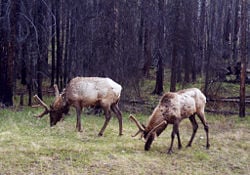
The park has 56 mammal species that have been recorded. Grizzly and Black bears inhabit the forested regions. Cougar, Lynx, Wolverine, weasel, Northern River Otter and wolves are the primary predatory mammals. Elk, Mule Deer and White-tailed Deer are common in the valleys of the park, including around (and sometimes in) the Banff townsite, while Moose tend to be more elusive, sticking primarily to wetland areas and near streams. In the alpine regions, Mountain Goats, Bighorn Sheep, marmots and pika are widespread. Other mammals such as Beaver, Porcupine, squirrel, chipmunks are the more commonly observed smaller mammals.[14] In 2005, a total of five caribou where counted, making this species one of the rarest mammals found in the park.[4]
Due to the harsh winters, the park has few reptiles and amphibians with only one species of toad, three species of frog, one salamander species and two species of snakes that have been identified.[14] At least 280 species of birds can be found in Banff including Bald and Golden Eagles, Red-tailed Hawk, Osprey, Falcon and Merlin, all of which are predatory species. Additionally, commonly seen species such as the Gray Jay, American Three-toed Woodpecker, Mountain Bluebird, Clark's Nutcracker, Mountain Chickadee and pipit are frequently found in the lower elevations. The White-tailed Ptarmigan is a ground bird that is often seen in the alpine zones. Rivers and lakes are frequented by over a hundred different species including loons, herons, and mallards who spend their summers in the park.[14]
Endangered species in Banff include the Banff Springs Snail Physella johnsoni which is found in the hot springs of Banff.[15] Woodland caribou, found in Banff, are listed as a threatened species, as are grizzly bears.
Mountain pine beetles
Mountain pine beetles have caused a number of large-scale infestations in Banff National Park, feeding off of the phloem of mature lodgepole pines. Alberta's first known outbreak occurred in 1940, infecting 17 square miles of forest in Banff.[16] A second major outbreak occurred in the late 1970s and early 1980s in Banff and the surrounding Rocky Mountains region.
History
Throughout its history, Banff National Park has been shaped by tension between conservation and development interests. The park was established in 1885, in response to conflicting claims over who discovered hot springs there, and who had the right to develop the hot springs for commercial interests. Instead, prime minister John A. Macdonald set aside the hot springs as a small protected reserve, which was later expanded to include Lake Louise and other areas extending north to the Columbia Icefields.
Early history
Archaeological evidence found at Vermilion Lakes radiocarbon dates the first human activity in Banff to 10,300 B.P.[17] Prior to European contact, aboriginals, including the Stoneys, Kootenay, Tsuu T'ina, Kainai, Peigans, and Siksika, were common in the region where they hunted bison and other game.[18]
With the admission of British Columbia to Canada on July 20, 1871, Canada agreed to build a transcontinental railroad. Construction of the railroad began in 1875, with Kicking Horse Pass chosen, over the more northerly Yellowhead Pass, as the route through the Canadian Rockies.[19] Ten years later, the last spike was driven in Craigellachie, British Columbia.
Rocky Mountains Park established
With conflicting claims over discovery of hot springs in Banff, Prime Minister John A. Macdonald decided to set aside a small reserve of 10 square miles around the hot springs at Cave and Basin as a public park in 1885. Under the Rocky Mountains Park Act, enacted on 23 June 1887, the park was expanded to 260 square miles[18] and named Rocky Mountains Park. This was Canada's first national park, and the second established in North America, after Yellowstone National Park. The Canadian Pacific Railway built the Banff Springs Hotel and Chateau Lake Louise to attract tourists and increase the number of rail passengers.
Early on, Banff was popular with wealthy European tourists, who arrived in Canada via trans-Atlantic luxury liner and continued westward on the railroad,[18] as well as upper-class American and English tourists. Some visitors participated in mountaineering activities, often hiring local guides. Tom Wilson, along with Jim and Bill Brewster, was among the first outfitters in Banff. The Alpine Club of Canada, established in 1906 by Arthur Oliver Wheeler and Elizabeth Parker, organized climbs and camps in the backcountry.
By 1911, Banff was accessible by automobile from Calgary. Beginning in 1916, the Brewsters offered motorcoach tours of Banff.[20] In 1920, access to Lake Louise by road was available, and the Banff-Windermere Road opened in 1923 to connect Banff with British Columbia.[19]
In 1902, the park was expanded to cover 4,402 square miles, encompassing areas around Lake Louise, and the Bow, Red Deer, Kananaskis, and Spray rivers. Bowing to pressure from grazing and logging interests, the size of the park was reduced in 1911 to 1,800 square miles, eliminating many foothills areas from the park. Park boundaries changed several more times up until 1930, when the size of Banff was fixed at 2,586 square miles, with the passage of the National Parks Act.[18] The Act also renamed the park as Banff National Park, named for the Canadian Pacific Railway station, which in turn was named after the Banffshire region in Scotland.[21] With the construction of a new east gate in 1933, Alberta transferred 207.5 acres to the park. This, along with other minor changes in the park boundaries in 1949, set the area of the park at 2,564 square miles.[19]
Coal mining
In 1887, local aboriginal tribes signed Treaty 7, which gave Canada rights to explore the land for resources. At the beginning of the twentieth century, coal was mined near Lake Minnewanka in Banff. For a brief period, a mine operated at Anthracite, but was shut down in 1904. The Bankhead mine, at Cascade Mountain, was operated by the Canadian Pacific Railway from 1903 to 1922. In 1926, the town was dismantled, with many buildings moved to the town of Banff and elsewhere.[22]
Prison and work camps
During World War I, immigrants from Austria, Hungary, Germany, and Ukraine were sent to Banff to work in internment camps. The main camp was located at Castle Mountain, and was moved to Cave and Basin during winter. Much early infrastructure and road construction was done by Slavic Canadian internees.[23]
In 1931, the Government of Canada enacted the Unemployment and Farm Relief Act which provided public works projects in the national parks during the Great Depression. In Banff, workers constructed a new bathhouse and pool at Upper Hot Springs, to supplement Cave and Basin.[23] Other projects involved road building in the park, tasks around the Banff townsite, and construction of a highway connecting Banff and Jasper.[23] In 1934, the Public Works Construction Act was passed, providing continued funding for the public works projects. New projects included construction of a new registration facility at Banff's east gate, and construction of an administrative building in Banff. By 1940, the Icefields Parkway reached the Columbia Icefield area of Banff, and connected Banff and Jasper.[24]
Internment camps were once again set up in Banff during World War II, with camps stationed at Lake Louise, Stoney Creek, and Healy Creek. Prison camps were largely composed of Mennonites from Saskatchewan.[23] Japanese internment camps were not stationed in Banff during World War II, but rather were located in Jasper National Park where their detainees worked on the Yellowhead Highway and other projects.
Winter tourism
Winter tourism in Banff began in February 1917, with the first Banff Winter Carnival. The carnival featured a large ice palace, which in 1917 was built by internees. Carnival events included cross-country skiing, ski jumping, curling, snowshoe, and skijoring.[25] In the 1930s, the first downhill ski resort, Sunshine Village, was developed by the Brewsters. Mount Norquay ski area was also developed during the 1930s, with the first chair lift installed there in 1948.[18]
Since 1968, when Banff Springs Hotel was winterized, Banff has been a year-round destination.[26] In the 1960s, the Trans-Canada Highway was constructed, providing another transportation corridor through the Bow Valley, in addition to the Bow Valley Parkway, making the park more accessible. Also in the 1960s, Calgary International Airport was built.
Canada launched several bids to host the Winter Olympics in Banff, with the first bid for the 1964 Winter Olympics which were eventually awarded to Innsbruck, Austria. Canada narrowly lost a second bid, for the 1968 Winter Olympics, which were awarded to Grenoble, France. Once again, Banff launched a bid to host the 1972 Winter Olympics, with plans to hold the Olympics at Lake Louise. The 1972 bid was most controversial, as environmental lobby groups provided strong opposition to the bid, which had sponsorship from Imperial Oil.[18] Bowing to pressure, Jean Chrétien, then the head of Parks Canada, withdrew support for the bid, which was eventually lost to Sapporo, Japan. Several events were hosted at the Canmore Nordic Center at Canmore, Alberta, located just outside the eastern gates of Banff National Park on the Trans-Canada Highway, when nearby Calgary, Alberta was awarded the 1988 Winter Olympics.
Conservation
Since the original Rocky Mountains Park Act, subsequent acts and policies placed greater emphasis on conservation. With public sentiment tending towards environmentalism, Parks Canada issued major new policy in 1979, which emphasized conservation. The National Parks Act was amended in 1988, which made preserving ecological integrity a top priority. The act also required each park to produce a management plan, with greater public participation.[18]
In 1984, Banff was declared a UNESCO World Heritage Site, together with the other national and provincial parks that form the Canadian Rocky Mountain Parks, for the mountain landscapes containing mountain peaks, glaciers, lakes, waterfalls, canyons and limestone caves as well as fossils found here. With this designation came added obligations for conservation.[27]
During the 1980s, Parks Canada moved to privatize many park services such as golf courses, and added user fees for use of other facilities and services to help deal with budget cuts. In 1990, the Town of Banff was incorporated, giving local residents more say regarding any proposed developments.[28]
In the 1990s, development plans for the park, including expansion at Sunshine Village, were under fire with lawsuits filed by Canadian Parks and Wilderness Society (CPAWS). In the mid-1990s, the Banff-Bow Valley Study was initiated to find ways to better address environmental concerns, and issues relating to development in the park.
Tourism
Banff National Park is the most visited Alberta tourist destination and one of the most visited national parks in North America, with 3,927,557 visitors in 2004/2005.[4][29] During summer, 42 percent of park visitors are from Canada (23 percent from Alberta), while 35 percent are from the United States, and 20 percent from Europe.[30] Tourism in Banff contributes an estimated C$6 billion annually to the economy.[31]
A park pass is required for stopping in the park and permit checks are common during the summer months, especially at Lake Louise and the start of the Icefields Parkway. A permit is not required if travelling straight through the park without stopping. Approximately 5 million people pass through Banff annually on the Trans-Canada Highway without stopping.[3]
Attractions in Banff include Upper Hot Springs, and a 27-hole golf course at Fairmont Banff Springs Hotel, and three ski resorts including Sunshine Village, Lake Louise Mountain Resort, and Mount Norquay ski resort. Day hikes, such as the Cory Pass Loop, are popular with visitors. Other activities include alpine and Nordic skiing and horseback riding.
Backcountry activities in Banff include hiking, camping, climbing, and skiing. Parks Canada requires those using backcountry campgrounds, Alpine Club of Canada huts, or other backcountry facilities to purchase a wilderness pass. Reservations for using the campgrounds are also required.
Park management
Banff National Park is managed by Parks Canada, under the National Parks Act which was passed in 1930. Over time, park management policies have increasingly emphasized environmental protection over development. In 1964, a policy statement was issued that reiterated ideals of conservation laid out in the 1930 act. With the controversial bid for the 1972 Winter Olympics, environmental groups became more influential, leading Parks Canada to withdraw its support for the bid. The 1979 Beaver Book was a major new policy, which emphasized conservation. In 1988, the National Parks Act was amended, making the maintenance of ecological integrity the top priority. The amendment also paved the way for non-governmental organizations to challenge Parks Canada in court, for breaches in adhering to the act. In 1994, Parks Canada established revised "Guiding Principles and Operating Policies," which included a mandate for the Banff-Bow Valley Study to draft management recommendations.[18] As with other national parks, Banff is required to have a Park Management Plan. On a provincial level, the park area and the included communities (other than the Town of Banff which is an incorporated municipality) are administered by Alberta Municipal Affairs as Improvement District No. 9 (Banff).[32]
Human impact
Ecology
Since the nineteenth century, humans have impacted Banff's ecology through introduction of non-native species, controls on other species, and development in the Bow Valley, among other human activities. Bison once lived in the valleys of Banff, but were hunted by indigenous people and the last bison was killed off in 1858.[33] Elk are not indigenous to Banff, and were introduced in 1917 with 57 elk brought in from Yellowstone National Park.[34] The introduction of elk to Banff, combined with controls on coyote and wolves by Parks Canada beginning in the 1930s, has caused imbalance of the ecosystem.[34] Other species that have been displaced from the Bow Valley include grizzly bears, cougars, lynx, wolverines, otter and moose. Beginning in 1985, gray wolves were recolonizing areas in the Bow Valley.[35] However, the wolf population has struggled, with 32 wolf deaths along the Trans-Canada Highway between 1987 and 2000, leaving only 31 wolves in the area.[36]
The population of bull trout and other native species of fish in Banff's lakes has also dwindled, with the introduction of non-native species including brook trout, and rainbow trout.[37] Lake trout, Westslope cutthroat trout, Chiselmouth are also rare native species, while Chinook salmon, White sturgeon, Pacific lamprey, and Banff longnose dace are likely extinct locally.[38] The Banff longnose dace, once only found in Banff, is now an extinct species.[38]
The Trans-Canada Highway, passing through Banff, has been problematic, posing hazards for wildlife due to vehicle traffic and as an impediment to wildlife migration. Grizzly bears are among the species impacted by the highway, which together with other developments in Banff, has caused fragmentation of the landscape. Grizzly bears prefer the montane habitat, which has been most impacted by development. Wildlife crossings, including a series of underpasses, and two wildlife overpasses, have been constructed at a number of points along the Trans-Canada Highway to help alleviate this problem.
Fire management
Parks Canada management practices, notably fire suppression, since Banff National Park was established have impacted the park's ecosystem. Since the early the 1980s, Parks Canada has adopted a strategy that employed prescribed burns, which helps to mimic effects of natural fires.
Development
In 1978, expansion of Sunshine Village ski resort was approved, with added parking, hotel expansion, and development of Goat's Eye Mountain. Implementation of this development proposal was delayed through the 1980s, while environmental assessments were conducted. In 1989, Sunshine Village withdrew its development proposal, in light of government reservations, and submitted a revised proposal in 1992. This plan was approved by the government, pending environmental review. Subsequently, Canadian Parks and Wilderness Society (CPAWS) filed a court injunction, which halted the development.[39] CPAWS also put pressure on UNESCO to revoke Banff's World Heritage Site status, over concerns that developments were harming the park's ecological health.[40]
Banff-Bow Valley Study
While the National Parks Act and the 1988 amendment emphasize ecological integrity, in practice Banff has suffered from inconsistent application of the policies.[31] In 1994, the Banff-Bow Valley Study was mandated by Sheila Copps, the minister responsible for Parks Canada, to provide recommendations on how to better manage human use and development, and maintain ecological integrity.[41] While the two-year Banff-Bow Valley Study was underway, development projects were halted, including the expansion of Sunshine Village, and the twinning of the Trans-Canada Highway between Castle Junction and Sunshine.
The panel issued over 500 recommendations, including limiting the growth of the Banff townsite, capping the town's population at 10,000, placing quotas for popular hiking trails, and curtailing development in the park.[31] Another recommendation was to fence off the townsite to reduce confrontations between people and elk. By fencing off the townsite, this measure was also intended to reduce access to this refuge for elk from predators, such as wolves that tended to avoid the townsite. Upon release of the report, Copps immediately moved to accept the proposal to cap the town population. She also ordered a small airstrip to be removed, along with a buffalo padlock, and cadet camp, that inhibited wildlife movement.
In response to concerns and recommendations raised by the Banff Bow Valley Study, a number of development plans were curtailed in the 1990s. Plans to add nine holes at the Banff Springs Golf Resort were withdrawn in 1996.
Canmore
With the cap on growth in the Town of Banff, Canmore, located just outside the Banff boundary, has been growing rapidly to serve increasing demands of tourists. Major developments proposals for Canmore have included the Three Sisters Golf Resorts, proposed in 1992, which has been subject of contentious debate, with environmental groups arguing that the development would fragment important wildlife corridors in the Bow Valley.[42]
ReferencesISBN links support NWE through referral fees
- ↑ The Mountain Guide - Banff National Park (PDF). Parks Canada (2006).
- ↑ Highway Mitigation Research. Parks Canada. Retrieved 2006-09-01.
- ↑ 3.0 3.1 Savage, Candace. "A Highway Runs Through It", Canadian Geographic, July/August 2000, pp. 34–42.
- ↑ 4.0 4.1 4.2 Park Management, Annual Planning Forum 2005. Parks Canada. Retrieved 2006-07-12.
- ↑ Baird, D.M. (1977). Banff National Park, How Nature Carved Its Splendor. Hurtig Publishers.
- ↑ Langshaw, Rick (1989). Geology of the Canadian Rockies. Summerthought.
- ↑ 7.0 7.1 7.2 7.3 7.4 Ommanney C.S.L. (2002). "Glaciers of the Canadian Rockies, Professional Paper 1386-J (Glaciers of North America)". U.S. Geological Survey.
- ↑ Brugman, Melinda M., Paul Raistrick, and Alain Pietroniro (1997). Glacier Related Impacts of Doubling Atmospheric Carbon Dioxide Concentrations on British Columbia and Yukon (pdf). Responding to Global Climate Change in British Columbia and Yukon. British Columbia Ministry of Environment, Lands and Parks.
- ↑ Scott, D. and Jones, B. (2005). Climate Change & Banff National Park: Implications for Tourism and Recreation (pdf). University of Waterloo.
- ↑ WWF International. Going, Going, Gone, Climate Change and Global Glacier Decline (pdf). Retrieved November 20, 2007.
- ↑ 11.0 11.1 Ecoregions of Banff National Park. Parks Canada.
- ↑ Cite error: Invalid
<ref>tag; no text was provided for refs namedgadd-1992 - ↑ Hebblewhite, Mark, Daniel H. Pletscher, and Paul C. Paquet (2002). Elk population dynamics in areas with and without predation by recolonizing wolves in Banff National Park, Alberta. Canadian Journal of Zoology 80: 789–799.
- ↑ 14.0 14.1 14.2 Canadian Rocky Mountain Parks. United Nations Environment Programme. Retrieved 2006-07-12.
- ↑ Species at risk - Banff Springs Snail. Environment Canada. Retrieved 2006-08-02.
- ↑ Mountain Pine Beetle Management Guide. Sustainable Resource Development, Government of Alberta (2004, January).
- ↑ Fedje, Daryl W., James M. White, Michael C. Wilson, D. Erle Nelson, John S. Vogel, John R. Southon (1995). Vermilion Lakes Site: Adaptations and Environments in the Canadian Rockies during the Latest Pleistocene and Early Holocene. American Antiquity 60(1): 81–108.
- ↑ 18.0 18.1 18.2 18.3 18.4 18.5 18.6 18.7 Hildebrandt, Walter (1995). "Historical Analysis of Parks Canada and Banff National Park, 1968–1995". Banff-Bow Valley Study.
- ↑ 19.0 19.1 19.2 Cite error: Invalid
<ref>tag; no text was provided for refs namedlothian - ↑ About Brewster - History. Retrieved 2006-08-03.
- ↑ Banff Townsite Area. Parks Canada. Retrieved 2006-06-13.
- ↑ Gadd, Benn (1989). Bankhead: The Twenty Year Town. Coal Association of Canada.
- ↑ 23.0 23.1 23.2 23.3 Waiser, Bill (1995). Park Prisoners, The Untold Story of Western Canada's National Parks, 1915–1946. Fifth House Publishers.
- ↑ Scott, Chic (2003). Summits & Icefields: Alpine Ski Tours in the Canadian Rockies. Rocky Mountain Books.
- ↑ Yeo, Bill (1990). "Making Banff a Year-Round Park". Winter Sports in the West, Alberta Historical Society.
- ↑ Hotel History. Fairmont Banff Springs.
- ↑ Advisory Body Evaluation (pdf). UNESCO (1992). Retrieved 2006-09-01.
- ↑ Banff National Park Management Plan. Parks Canada (May 2004). Retrieved 2006-09-01.
- ↑ Report on the State of Conservation of Canadian Rocky Mountain Parks. Parks Canada. Retrieved 2006-06-23.
- ↑ State of the Park Report: An Assessment of the State of a Place for People. Parks Canada. Retrieved 2006-06-23.
- ↑ 31.0 31.1 31.2 Page, Robert, Suzanne Bayley, J. Douglas Cook, Jeffrey E. Green, J.R. Brent Ritchie (1996, October). "Banff-Bow Valley: At the Crossroads - Summary Report". Banff-Bow Valley Task Force.
- ↑ Improvement District No. 9 (Banff) - Alberta Municipal Affairs
- ↑ Wildlife of Banff National Park. Parks Canada. Retrieved 2006-07-19.
- ↑ 34.0 34.1 Luxton, Eleanor Georgina (1979). Banff, Canada's First National Park: a history and a memory of Rocky Mountains park. Summerthought.
- ↑ Paquet, P.C., Gibeau, M.L., Herrero, S., Jorgenson, J., and J. Green. (1994). Wildlife corridors in the Bow River Valley, Alberta: A strategy for maintaining well-distributed, viable populations of wildlife.
- ↑ Struzik, Ed. "Wolves losing mountain park turf to humans: Traffic congestion in Jasper and Banff gravely impacting park populations", Edmonton Journal, 2000, March 12, p. A6.
- ↑ Schindler, David W. (2000). Aquatic problems caused by human activities in Banff National Park, Alberta, Canada. Ambio 29(7): 401–407.
- ↑ 38.0 38.1 Barnett, Vicki. "Native fish stocks drastically down in central Rockies", Calgary Herald, 1996, March 10, p. D1.
- ↑ Fuller, Patty. "No ray of light for Sunshine Village", Alberta Report, 1994, February 14.
- ↑ Adams, Jeff. "Twinning Breaks Pledge, Says Expert", Calgary Herald, 1993, April 16, p. B11.
- ↑ Banff-Bow Valley Study, Technical Report, chapter 1.
- ↑ Barnett, Vicki. "Stakes are high for resort", Calgary Herald, 1992, July 26, p. A8.
External links
- Banff National Park of Canada. Official Banff National Park website. Retrieved November 20, 2007.
- Town of Banff. Official Town of Banff Website. Retrieved November 20, 2007.
- Banff National Park. Canadian Mountain Encyclopedia. Retrieved November 20, 2007.
- Silent Narratives. Whyte Museum of the Canadian Rockies. Retrieved November 20, 2007.
- Banff. Hike Alberta. Retrieved November 20, 2007.
| ||||||||||||||||
| ||||||||||
Credits
New World Encyclopedia writers and editors rewrote and completed the Wikipedia article in accordance with New World Encyclopedia standards. This article abides by terms of the Creative Commons CC-by-sa 3.0 License (CC-by-sa), which may be used and disseminated with proper attribution. Credit is due under the terms of this license that can reference both the New World Encyclopedia contributors and the selfless volunteer contributors of the Wikimedia Foundation. To cite this article click here for a list of acceptable citing formats.The history of earlier contributions by wikipedians is accessible to researchers here:
The history of this article since it was imported to New World Encyclopedia:
Note: Some restrictions may apply to use of individual images which are separately licensed.
